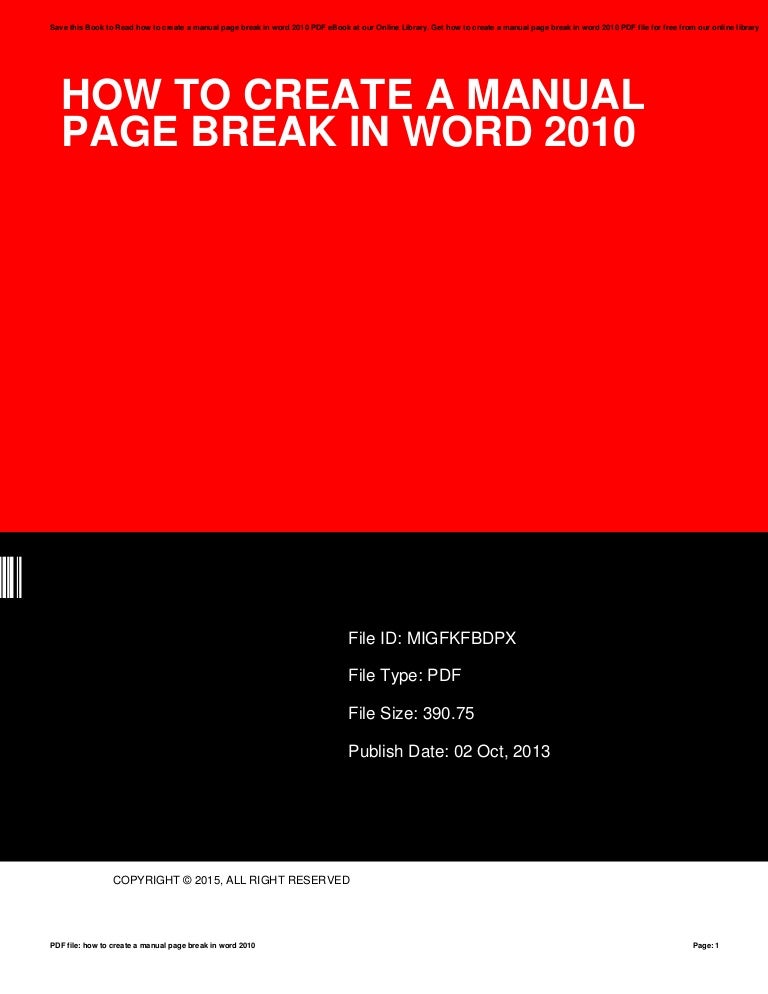Page break: Use a page break (in a word-processing document only) to move a line of text to the top of the next page or to start typing on a new page. You can also prevent single lines of text from appearing on their own at the bottom or top of a page (these are known as widows and orphans). Force text to the next line or page.
- Manual Page Break Word Mac Os
- Insert Page Break Word Mac
- Manual Page Break Word Mac Free
- Insert Page Break Word Mac Keyboard Shortcut
Extracted from: http://support.microsoft.com/kb/214204
NOTE: The caret character (^) in the following tables must be typed. The caret character is created by pressing SHIFT+6 on most keyboards. (Do not confuse this character with the CTRL key.)
Manual Page Break Word Mac Os
- Remove all breaks (page breaks, column breaks, section breaks, all breaks) in selection or the whole document with one click: In Word, to remove the page breaks or section breaks, you just can remove them one by one manually or use the VBA code which is time-wasted.
- Whenever the printer encounters a page break, it will print a new page. MS Word documents can include both automatic and manual page breaks. Sometimes a document can accumulate a large number of.
'Find what' Box Only
The following characters can only be used in the Find what box.
Character | String |
^1 or ^g | Picture (inline pictures only) |
^2, ^f (footnote), or ^e (endnote) | Auto-referenced footnotes or endnotes |
^5 or ^a | Annotation/comment mark |
^19 or ^d | Opening field brace (Use only when you are viewing field codes.) (Selects whole field, not just opening brace.) |
^21 or ^d | Closing field brace (Use only when you are viewing field codes.) (Selects whole field, not just closing brace.) |
^? | Any single character |
^# | Any digit |
^$ | Any letter |
^u8195 | Em space Unicode character value search |
^u8194 | En space Unicode character value search |
^b | Section break |
^w | White space (space, nonbreaking space, tab) |
^unnnn | Word 2000 Unicode character search, where 'n' is a decimal number corresponding to the Unicode character value |
'Replace with' Box Only

The following characters can only be used in the Replace with box.
Character | String |
^& | Contents of the 'Find what' box |
^c | Replace with the Clipboard contents |
Both 'Find what' and 'Replace with' Boxes
The following characters can be used in both the Find what and Replace with boxes.
Insert Page Break Word Mac
Character | String |
^9 or ^t | Tab |
^11 or ^l | New line |
^12 | Page or section break (Replaces a section break with a page break) |
^13 or ^p | Carriage return/paragraph mark |
^14 or ^n | Column break |
? | Question mark |
^- | Optional hyphen |
^~ | Nonbreaking hyphen |
^^ | Caret character |
^+ | Em dash |
^= | En dash |
^m | Manual page break |
^s | Nonbreaking space |
^nnn | Where 'n' is an ASCII character number |
^0nnn | Where 'n' is an ANSI character number |
Example: Replacing paragraph breaks in MS Word
PROBLEM: How do I replace paragraph breaks in a text file or MS Word document?
SOLUTION: Using the Find and Replace dialog, use the escape character sequence ^p (shift-6 p) to search for or insert paragraph breaks.
Manual Page Break Word Mac Free
